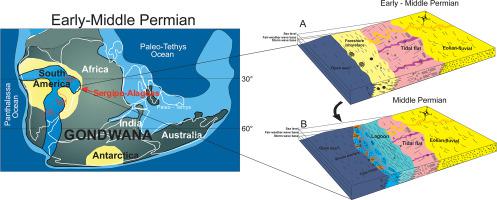Sedimentary Geology ( IF 2.8 ) Pub Date : 2021-01-06 , DOI: 10.1016/j.sedgeo.2020.105829 Rafael Oliveira Silva , Mariangela Garcia Praça Leite , Isaac Rudnitzki , Wagner Souza-Lima

|
Although in recent years mixed carbonate–siliciclastic platforms have been increasingly recognized in the Permian of Western Gondwana, there is no detailed description of these mixed systems in West-Central Gondwana. This study focuses on the Permian of the Sergipe–Alagoas Basin (NE Brazil), with the aim of filling this knowledge gap. Based on sedimentological data and microfacies analysis, six facies associations (FA) were identified: FA1 is an eolian–fluvial system, composed of stratified sandstones, FA2 and FA3 represent a mixed tidal flat–lagoon system composed of microbialites, pelitic/micritic sediments and intraclastic packstones, FA4 represents shoreface wave deposits composed of laminated sandstones and silicified grainstones, and FA5 and FA6 are interpreted as a barrier–tidal inlet system, composed of oolitic/intraclastic grainstones, subtidal microbialites, and mixed rudstones. Facies associations reflect the paleoenvironmental conditions of a coastal environment, with dunes and small rivers adjacent to a mixed carbonate–siliciclastic ramp. This is defined as a lagoon system associated with tidal flats protected from the high-energy region by carbonate shoals and microbial constructions. These deposits represent the eastern portion of a shallow epicontinental sea that covered lowlands in West-Central Gondwana within the arid–semiarid belt, whose climate characteristics are reflected in eolian deposits, desiccation structures, mixed carbonate–siliciclastic facies, and fossil records. The main diagenetic feature observed in petrographic analyses was an early diagenetic silicification. Although the absence of spiculites and shelf configuration did not allow a correlation with the Permian glass ramp model, similarities were observed with Eocene glass ramps of Australia, and a relationship with the Permian Chert Event is suggested.
中文翻译:

冈瓦纳中西部的二叠纪碳酸盐-硅质碎屑泻湖混合海岸带系统
尽管近年来,在冈瓦纳西部的二叠纪中碳酸盐-硅质碎屑混合平台越来越得到认可,但在冈瓦纳中西部没有对这些混合体系的详细描述。这项研究的重点是塞尔吉普-阿拉戈斯盆地(巴西东北部)的二叠纪,目的是填补这一知识空白。根据沉积学数据和微相分析,确定了六个相协会(FA):FA1是风化-河流系统,由分层的砂岩组成,FA2和FA3代表潮汐平面-泻湖混合系统,由微辉石,胶体/微胶质沉积和碎屑内堆积岩,FA4代表由层状砂岩和硅化颗粒岩组成的岸面波沉积物,FA5和FA6被解释为由潮质/非弹性颗粒岩组成的屏障-潮汐入口系统,潮下带微生物岩和混合质石。相联系反映了沿海环境的古环境条件,沙丘和小河毗邻碳酸盐-硅质碎屑混合斜坡。这被定义为一个泻湖系统,与通过碳酸盐浅滩和微生物构造保护免受高能区域影响的滩涂有关。这些沉积物代表了一个浅表陆大陆海的东部,覆盖了干旱至半干旱带内冈萨瓦中西部的低地,其气候特征反映在风成沉积物,干燥结构,碳酸盐-硅质碎屑相和化石记录中。岩石学分析中观察到的主要成岩特征是早期成岩硅化作用。


























 京公网安备 11010802027423号
京公网安备 11010802027423号